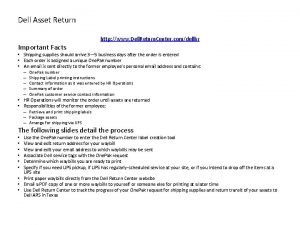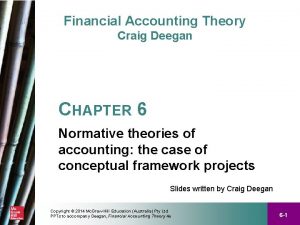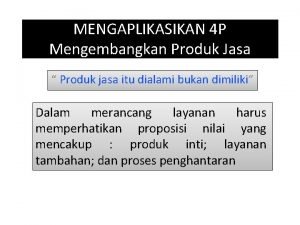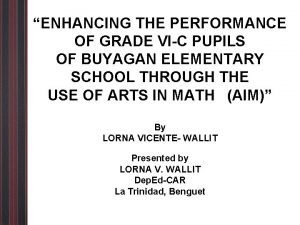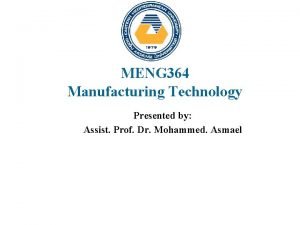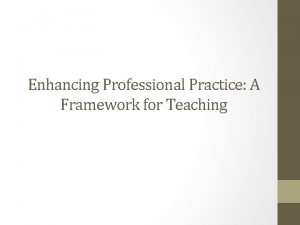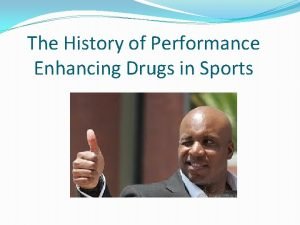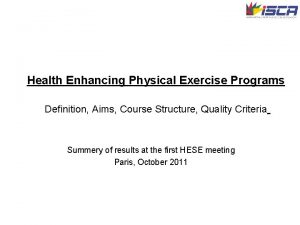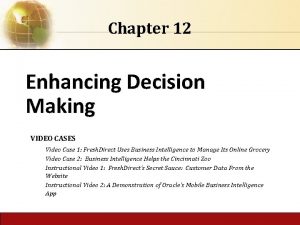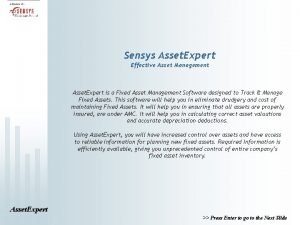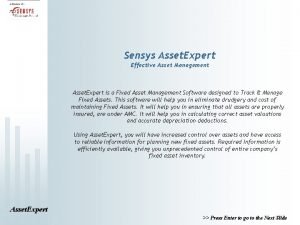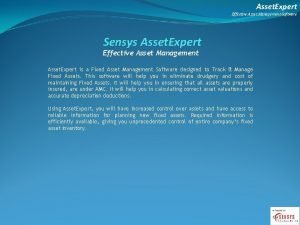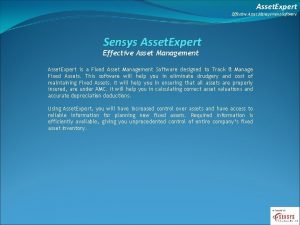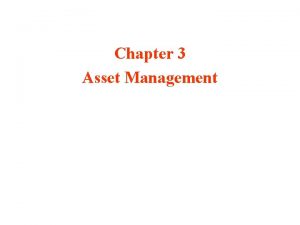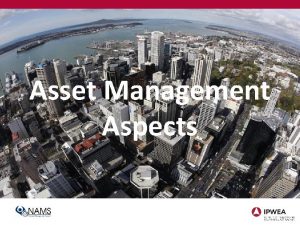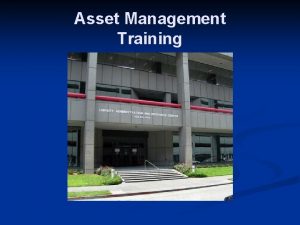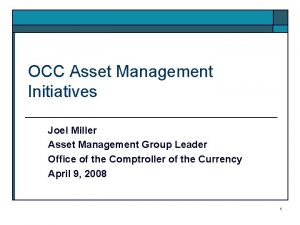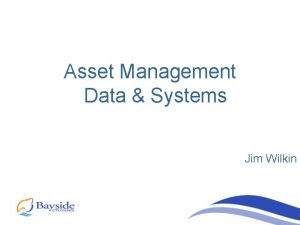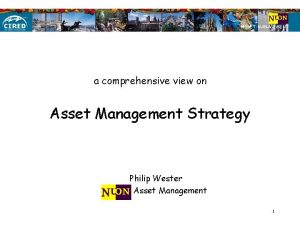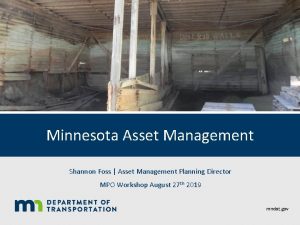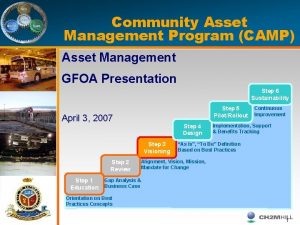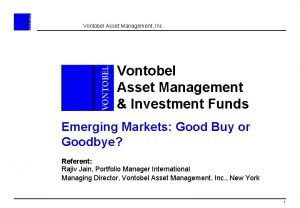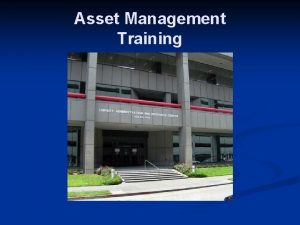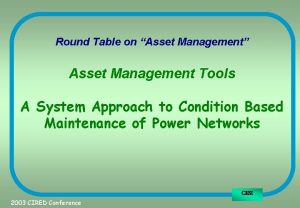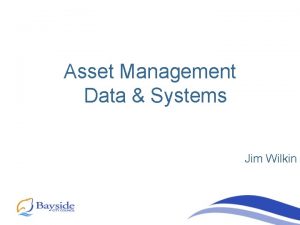Asset Management A Key Tool for Enhancing the







































- Slides: 39

Asset Management: A Key Tool for Enhancing the Sustainability of our Transportation Infrastructure Gerardo W. Flintsch Professor of Civil and Environmental Engineering Director, Center for Sustainable Transportation Infrastructure

Outline 1. Introduction 2. 3. Asset management Performance management State of Good Repair Decision Making Multiple criteria decision-making Multi-objective optimization Examples 4. Adding environmental considerations to the pavement management process Cross-asset management More sustainable rehabilitation Conclusions Center for Sustainable Transportation Infrastructure

1. Introduction Ed Stein Center for Sustainable Transportation Infrastructure

Why do we need to “manage” our Highway Infrastructure? o To preserve our infrastructure value Key component of the asset management o To develop “optimum” preservation and renewal programs Better Use of Available Resources o To provide a level of service that the user considers appropriate State of Good Repair Center for Sustainable Transportation Infrastructure

Each category was evaluated on the basis of capacity, condition, funding, future need, operation and maintenance, public safety and resilience. Center for Sustainable Transportation Infrastructure

Transportation Performance Management What Is Asset Management? Asset management is a strategic and systematic process of operating, maintaining, and improving physical assets, with a focus on engineering and economic analysis based upon quality information…. (23 U. S. C. 101(a)(2), MAP-21 § 1103) NHS Plan • Inventory, condition, risk, financial plan, investment strategies • Leads to a program of projects • Process certified every 4 years , to identify a structured sequence of maintenance, preservation, repair, rehabilitation, and replacement actions that will achieve and sustain a desired state of good repair over the lifecycle of the assets at minimum practicable cost. Performance Management Implementation Overview Source: P. Stephanos, Pavement Evaluation 2014

The Asset Management Business Process INFORMATION MANAGEMENT STRATEGIC ANALYSIS Goals & Policies System Performance Economic / Social & Environmental Budget Allocations PRODUCTS DATABASE INVENTORY CONDITION USAGE MAINTENANCE STRATEGIES NETWORK-LEVEL ANALYSIS CONDITION ASSESSMENT PERFORMANCE PREDICTION Economic, Social and Environmental Impacts PRIORITIZATION / OPTIMIZATION NETWORK-LEVEL REPORTS Performance Assessment Network Needs Facility Life-cycle Cost Optimized M&R Program Performance-based Budget PROGRAMMING FEEDBACK NEEDS ANALYSIS (PROJECT SELECTION) GRAPHICAL DISPLAYS PERFORMANCE MONITORING PROJECT LEVEL ANALYSIS (Design) WORK PROGRAM EXECUTION CONSTRUCTION DOCUMENTS

Transportation Performance Management The MAP-21 Charge (23 USC 150(a) - Declaration of Policy) Performance Management Will: • transform the Federal program • provide a means to the most efficient investment of funds By: • refocusing on national transportation goals, • increasing accountability & transparency, and • improving project decision making Performance Management Implementation Overview Source: P. Stephanos, Pavement Evaluation 2014

Condition of Principal Highways Interstate Pavement Smoothness (IRI) by State Highway Fatality Rates: 1980 -2009 Source: http: //www. fhwa. dot. gov/policyinformation/pubs/hf/pl 11028/chapter 7. cfm Center for Sustainable Transportation Infrastructure

Performance Measures as Communication Tools Source: NCHRP 551 Center for Sustainable Transportation Infrastructure

State of Good Repair Working definition: A state that results from application of transportation asset management concepts in which an agency maintains its physical assets according to a policy that minimizes asset life cycle costs while avoiding negative impacts to service Center for Sustainable Transportation Infrastructure

State of Good Repair o o Easy to assess in its absence Common themes: Achieving / meeting a certain level of service (performance) Performing maintenance, repair, rehabilitation and renewal according to a considered agency policy Reducing or eliminating a backlog of unmet capital needs → Asset Management Center for Sustainable Transportation Infrastructure

2. Decision Making Center for Sustainable Transportation Infrastructure

Traditional Goals Used for Managing our Transportation Assets o o o Minimize Costs (both agency and user) Maximize Benefits (e. g. , better pavement performance, etc. ) But, what if we want to consider all the performance measures? Environmental Impacts? Safety (social)? etc… Center for Sustainable Transportation Infrastructure

U. S. Map -21 National Goals Focus the Federal-aid program on the following national goals: 1. Safety 2. Infrastructure condition 3. Congestion reduction 4. System reliability 5. Freight movement and economic vitality 6. Environmental sustainability 7. Reduced project delivery delays Source: http: //www. fhwa. dot. gov/policyinformation/present Center for Sustainable Transportation Infrastructure ations/

Triple Bottom Line Economic Development • Meet financial and economic needs of current and future generations Sustainable Social Equity • Improve the quality of life for all people • Promote equity between societies, groups, and generations Environmental Stewardship • Clean environment for current and future generations • Use resources sparingly. Center for Sustainable Transportation Infrastructure

Performance Measures Stipulated in MAP 21 (§ 150(c)) PROGRAM MEASURE CATEGORY Pavement Condition on the Interstates National Highway Pavement Condition on Non-Int. NHS Performance Bridge Condition on NHS Program Performance of Interstate System Performance of Non-Interstate NHS Serious Injuries per VMT Highway Safety Fatalities per VMT Improvement Number of Serious Injuries Program Number of Fatalities Traffic Congestion CMAQ Program On-road Mobile Source Emissions Freight Movement on the Interstate Freight Policy for Sustainable Transportation Infrastructure Source: T. Van, 11 th. Center Infrastruture Management Research and Education

Multiple Criteria Decision-Making (MCDM) o Multi-objective decision-making (MODM) Considering multiple, often conflicting objectives o Multi-attribute decision-making (MADM) Based on classic decision analysis/ utility theory Center for Sustainable Transportation Infrastructure

Optimization o o Decision-support tool Selects best combination of: Sections/facilities (where) Treatment categories (what) Application time (when) o o Uses operations research techniques Must be based on a realistic decision -making process. Center for Sustainable Transportation Infrastructure

Multi-Objective Optimization o o o Sustainable transportation systems requires decisions in a context of Economic development High-level Ecological sustainability Performance Social desirability Indicators All resource allocation involve some kind of tradeoff Multi-objective optimization finds a set of decision variables (Pareto set of solutions) Satisfies constraints “Balances” various objective functions (performance criteria)

The Incremental Benefit Cost (IBC) is a Form of Multi-objective/ Multi-criteria Analysis Strategy 6 Benefits Efficiency Frontier Strategy 3 Strategy 2 Strategy 1 Strategy 4 Strategy 5 IBC = D Benefits D Costs Do-nothing Cost Center for Sustainable Transportation Infrastructure

3. Examples Center for Sustainable Transportation Infrastructure

Example 1 - Adding a 3 rd Objective: Minimizing the Life Cycle environmental Impact o Objectives: Assess the environmental impacts of road-related practices, strategies, and materials Implement a procedure to include these ecoefficiency values into a more comprehensive decision support system Evaluation of alternatives/ strategies Costs Performance Multi. Attribute optimization Optimal Strategy Environment Giustozzi, Crispino, & Flintsch, Life Cycle Assessment of Preventive Center“Multi-Attribute for Sustainable Transportation Infrastructure Maintenance Treatments on Road Pavements for Achieving Environmental Sustainability, ”

Sustainability Triple Bottom Line Costs Economic Development • Meet financial and economic needs of current and future generations Performance Social Equity • Improve the quality of life for all people • Promote equity between societies, groups, and generations Environmental Impacts Environmental Stewardship • Clean environment for current and future generations • Use resources sparingly. Center for Sustainable Transportation Infrastructure

PMS 3 rd Objective: Life Cycle Assessment (simplified to consider GHG only) 1 • Materials 2 • Transportation 3 • Construction, Maintenance 4 • Equipment 5 • Usage Phase 6 • Recycling, Disposal, Landfill Carbon Footprinting Center for Sustainable Transportation Infrastructure

Example 1: Multi-Objective Evaluation of Alternatives Environment Life Cycle Assessment 1/ Pe rfo rm an ce Costs Center for Sustainable Transportation Infrastructure

Example 2 - Cross-Asset Management

Hypothesis (linking condition to performance) Poor Condition Consequences System Performance Center for Sustainable Transportation Infrastructure

Example 2: System-level Performance I-81 Corridor Analysis o o Rating of individual component asset performance Aggregation Corridor level System level Verhoeven & Flintsch, “Generalized Framework for. Infrastructure Developing a Center for Sustainable Transportation Corridor-Level Infrastructure Health Index, ” Journal of the

Pilot Application on I-81 o Pavement data from PMS o IRI, Rutting, Cracking Bridge data from NBI Element level inspections Section PHR BHR Final CHR MP 50 -110 7. 98 8. 36 8. 06 MP 250 -300 Center 7. 91 8. 69 8. 07 for Sustainable Transportation Infrastructure

Pilot Application (Simplified Example) Scenario 50% 40% 30% 20% 10% 8. 8 8. 6 Functional Indicator 8. 4 Indicator selected Treatment applied based on budget Performance averaged over 5 year analysis period Bridge Budget Share 8. 2 8 Overall Indicator 7. 8 7. 6 Structural Indicator 7. 4 7. 2 7 50% 60% 70% 80% 90% Pavement Budget Share Optimal allocation Center for Sustainable Transportation Infrastructure

Impact on Network Performance Conceptual Framework Dehghanisanij, M. , Flintsch, G. W. , Mc. Neil, S. , “Roadway Networks as a Degrading System: Vulnerability and System-level Performance, ” Transportation Letters: the International Journal of Transportation Engineering, 2013, vol. 5 (3), pp 105 -114 Center for Sustainable Transportation Infrastructure

Example 3 - More Sustainable Rehabilitation Techniques - I-81 In Situ Recycling Cold In-place Recycling (CIR) Full Depth Reclamation (FDR) Cold Central Plant Recycling (CCPR) Center for Sustainable Transportation Infrastructure

Source: http: //www. infrastructurereportcard. org/a/#p/roads/success-stories Center for Sustainable Transportation Infrastructure

LCCA Comparisons – Detailed Comparison 25 5 $ 0. 2332 $ 0. 6856 $ 0. 4720 10 $ 0. 3582 $ 0. 7261 $ 0. 5221 15 $ 2. 4386 $ 4. 5387 $ 4. 7378 NPV [M$] 20 $ 27. 6173 $ 9. 1215 $ 10. 1087 $ 18. 4943 30 Corrective Maintenance $ 14. 4648 $ 18. 3723 Traditional Reconstruction $ 2. 4651 $ 3. 5270 Recycling-based 0 Materials Construction Transportation WZ Traffic Extraction and M&R of Materials Management Production Usage EOL Total $ (0. 1519) $ (0. 1359) -5 Pavement life cycle phase Santos, J. , Bryce, J. , Flintsch, G. W. , and Ferreira, A. “A Comprehensive Life Cycle Costs Analysis of In-Place Recycling and Conventional Pavement Construction and Maintenance Practices, ” under review.

LCA Results – Impact on Climate Change Corrective Maintenance Traditional Reconstruction 112 926 7 335 3 942 3 593 469 206 216 152 1 000 260 721 3 347 10 000 3 788 100 000 2 100 Tonnes of CO 2 - eq 112 926 1 000 156 859 Recycling-based 100 Construction and M&R Transportation WZ Traffic Mangement Usage EOL 0 Materials Santos, J. , Bryce, J. , Flintsch, G. W. , Ferreira, A. and Diefenderfer, B. “A life cycle assessment of in-place recycling and conventional pavement construction and maintenance practices, ” Structure and Infrastructure Engineering: Maintenance, Management, Life-Cycle Design and Performance, 2014

4. Conclusions Center for Sustainable Transportation Infrastructure

Conclusions o → Asset management is a key business process for highway agencies Helps develop preservation and renewal programs and budgets consistent with user expectations (performance) Allows aligning investment with performance goals/ objectives Sound asset management practices are needed to provide sustainable highway infrastructure systems Center for Sustainable Transportation Infrastructure

Asset Management: A Key Tool for Enhancing the Sustainability of our Transportation Infrastructure Questions? flintsch@vt. edu
 Dell asset management software
Dell asset management software Asset management vs project management
Asset management vs project management Four enhancing qualitative characteristics
Four enhancing qualitative characteristics Enhancing professional practice
Enhancing professional practice Danielson framework components
Danielson framework components Enhancing personal effectiveness
Enhancing personal effectiveness Enhancing supplementary services
Enhancing supplementary services Enhancing thermal conductivity of fluids with nanoparticles
Enhancing thermal conductivity of fluids with nanoparticles Enhancing the performance of grade vi-c
Enhancing the performance of grade vi-c Privacy-enhancing computation
Privacy-enhancing computation Explain property-enhancing operations
Explain property-enhancing operations Enhancing a presentation with multimedia
Enhancing a presentation with multimedia Enhancing professional practice a framework for teaching
Enhancing professional practice a framework for teaching Enhancing decision making
Enhancing decision making History of performance enhancing drugs
History of performance enhancing drugs Health enhancing definition
Health enhancing definition Enhancing decision making
Enhancing decision making Business canvas example
Business canvas example Contoh bisnis model canvas makanan pdf
Contoh bisnis model canvas makanan pdf Potter's wheel data cleaning tool
Potter's wheel data cleaning tool Iso 22301 utbildning
Iso 22301 utbildning Novell typiska drag
Novell typiska drag Tack för att ni lyssnade bild
Tack för att ni lyssnade bild Ekologiskt fotavtryck
Ekologiskt fotavtryck Varför kallas perioden 1918-1939 för mellankrigstiden?
Varför kallas perioden 1918-1939 för mellankrigstiden? En lathund för arbete med kontinuitetshantering
En lathund för arbete med kontinuitetshantering Kassaregister ideell förening
Kassaregister ideell förening Tidbok
Tidbok Anatomi organ reproduksi
Anatomi organ reproduksi Densitet vatten
Densitet vatten Datorkunskap för nybörjare
Datorkunskap för nybörjare Stig kerman
Stig kerman Mall debattartikel
Mall debattartikel Autokratiskt ledarskap
Autokratiskt ledarskap Nyckelkompetenser för livslångt lärande
Nyckelkompetenser för livslångt lärande Påbyggnader för flakfordon
Påbyggnader för flakfordon Lufttryck formel
Lufttryck formel Offentlig förvaltning
Offentlig förvaltning Jag har nigit för nymånens skära
Jag har nigit för nymånens skära Presentera för publik crossboss
Presentera för publik crossboss
